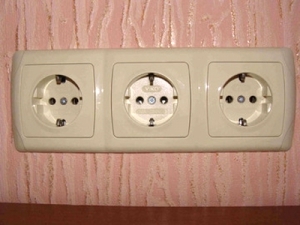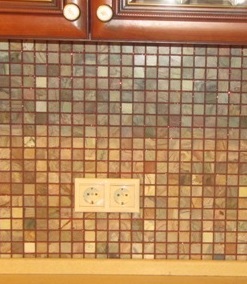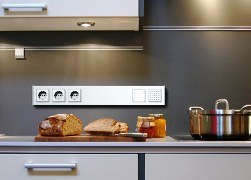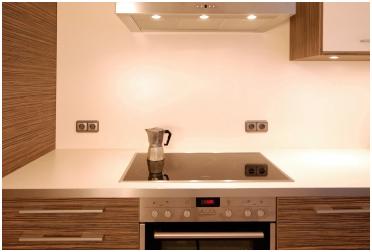Content
-
1 Kitchen sockets
- 1.1 Varieties
- 1.2 number
- 1.3 Location
- 1.4 Height
- 2 Outcome
When designing a kitchen setting, most people pay all their attention to a selection of furniture and kitchen appliances. This is a completely understandable pattern, since the beauty and convenience of the room where the cooking process will be carried out mainly depends on these components. However, correctly located sockets play an important role in the arrangement of the kitchen.

Without them, nowhere!
Properly distributed power points for electrical appliances are a guarantee of the convenience of using all the necessary units that, in one way or another, are related to cooking. In this regard, before starting to decorate the interior of the kitchen, first of all it is necessary make sure that the number of outlets and their location fully correspond to your needs. Our instruction + video on where to put sockets in the kitchen will help you make the operation of the kitchen as comfortable as possible.
Read also how to integrate a dishwasher into a finished kitchen.
Kitchen sockets
Varieties

"European" connection type
The choice of jackets for sockets is quite large, but the external design does not have any impact on the technical side. The only thing to pay attention to is the diameter of the inlet holes for the plug. In most cases, they are divided into two types - ordinary and the so-called "European".
"European" counterparts have a larger hole diameter, and their design may include a third hole, which is necessary for grounding the connected electrical appliance. This type of outlet is much preferable, since most of the kitchen appliances are manufactured abroad and, accordingly, you should focus on this standard. It should be noted that their price is slightly higher than their domestic counterparts, but the difference is not so significant as to sacrifice compatibility.
Note! When installing outlets with your own hands, you should take into account that grounding on devices of the "European" type requires a ground wire - without it, it is not possible to connect this function possible.
number
In this case, the “more is better” principle should be followed. As mentioned above, it is necessary to take into account not only the potential number of electrical appliances, the acquisition of which is planned initially, but also possible unforeseen connections. If you do not take this point into account, then most likely you will have to use various kinds of tees and extension cords, which in itself does not really correspond to the concept of convenience.
It is best to initially give preference to structures that include two or three points connections - so you will be completely insured against the need to use third-party accessories.
Read also expert advice on how to install an MDF apron in the kitchen.
Location

Sockets in the kitchen photo
To determine where to make sockets in the kitchen, you first need to understand the location of the main consumers of electricity. Appliances exceeding average power must be supplied from separate power sources, as excessive loading may melt the outer casing of the socket.
Without fail, a separate power supply should be near such devices as:
- Fridge;
- Dishwasher;
- Electric stove;
- An oven if its power exceeds 5 watts;
- Washing machine.
In addition to large electrical appliances, you should also consider the presence of less powerful components, such as: microwave oven, mixer, TV, food processor and etc. For their power supply, a combined group of outlets is most suitable, which is located depending on the location of future electricity consumers.
Note! This order is also necessary for the correct distribution of voltage between the devices that are included in the network. If this rule is not observed, malfunctions may occur during the operation of some parts of the electrical equipment.
Height

Group of points for connecting medium power devices
Finally, we come close to the question, at what height to make sockets in the kitchen? The convenience of using electrical appliances directly depends on the correctly selected height - in most cases, the length of the cord through which they are connected to the network is very limited. They should also be positioned so that they do not interfere with daily use. Otherwise, you will either have to move the unit closer or use an extension cord, which is not very convenient.
There are certain standards that will help you determine what exactly the height of the sockets from the floor in the kitchen will have the optimal value in each case.
- Most often, the power point for low-power electrical appliances is located close to the working area of the kitchen, since for the most part, such things as a mixer, electric kettle, etc., “live” there. It should be about 115-110 cm above the top visible floor surface.
Note! This value should also take into account the height of the kitchen unit, if any - the power source must be located at a height of 10-15 cm from the surface of the countertop. This is necessary for the comfortable connection of electrical appliances.
- Height of sockets for more powerful equipment - electric stove, refrigerator, etc. determined by their original location in the kitchen. Power points should be located on the side of the unit at a height of about 10-15 cm from the floor.
- You should also take care of additional connection points that are designed for various unexpected connections - they should be located at a height of 20-30 cm from the floor.
Outcome

The height of the socket in the kitchen is 15 cm above the working area
So that you do not have the need to move the units closer to the connection point or use extension cords, you need to think about where to make sockets in the kitchen in advance. Correctly positioned sockets will make the use of kitchen appliances much more convenient and comfortable.
Read also all about DIY kitchen hood repair.

